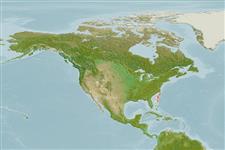Elasmobranquios (tiburones y rayas) (sharks and rays) >
Rajiformes (Skates and rays) >
Rajidae (Skates)
Etymology: Neoraja: Greek, neos = new + Latin, raja = fish, Raja sp. (Ref. 45335); carolinensis: Named after the the type locality, the Carolinian Province of the western North Atlantic (Ref. 31400).
Environment: milieu / climate zone / depth range / distribution range
Ecología
marino batidemersal; rango de profundidad 695 - 1010 m (Ref. 31400). Deep-water; 35°N - 29°N
Western Central Atlantic: continental slope off the southeastern USA.
Tamaño / Peso / Age
Maturity: Lm ? range ? - ? cm
Max length : 28.5 cm TL macho / no sexado; (Ref. 31400)
Anterior lobe of pelvic fin nearly as long or longer than posterior lobe of fin; dorsal surface of tail without distinct cross-bars; abdominal area uniformly dark colored and sharply marked off from light interbranchial and cloacal regions (Ref. 31400).
Found in the continental slope (Ref. 31400). Oviparous (Ref. 50449). Eggs have horn-like projections on the shell (Ref. 205).
Life cycle and mating behavior
Madurez | Reproducción | Puesta | Huevos | Fecundidad | Larva
Oviparous, paired eggs are laid. Embryos feed solely on yolk (Ref. 50449).
McEachran, J.D. and K.A. Dunn, 1998. Phylogenetic analysis of skates, a morphologically conservative clade of elasmobranchs (Chondrichthyes: Rajidae). Copeia 1998(2):271-290. (Ref. 27314)
IUCN Red List Status (Ref. 130435: Version 2024-1)
Threat to humans
Harmless
Human uses
Herramientas
Special reports
Download XML
Fuentes de Internet
Estimates based on models
Preferred temperature (Ref.
123201): 9.1 - 9.9, mean 9.6 °C (based on 14 cells).
Phylogenetic diversity index (Ref.
82804): PD
50 = 0.5312 [Uniqueness, from 0.5 = low to 2.0 = high].
Bayesian length-weight: a=0.00302 (0.00141 - 0.00645), b=3.24 (3.07 - 3.41), in cm total length, based on LWR estimates for this (Sub)family-body shape (Ref.
93245).
Nivel trófico (Ref.
69278): 3.6 ±0.5 se; based on size and trophs of closest relatives
Resiliencia (Ref.
120179): Bajo, población duplicada en un tiempo mínimo de 4.5-14 años (Fec assumed to be <100).
Fishing Vulnerability (Ref.
59153): Low vulnerability (19 of 100).
